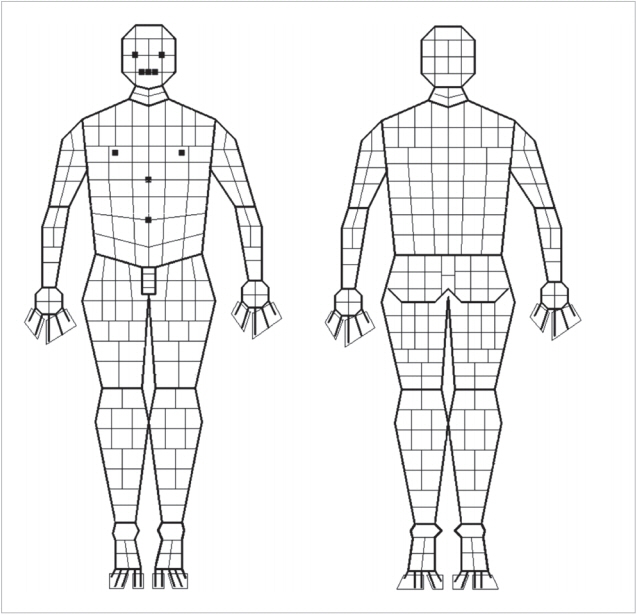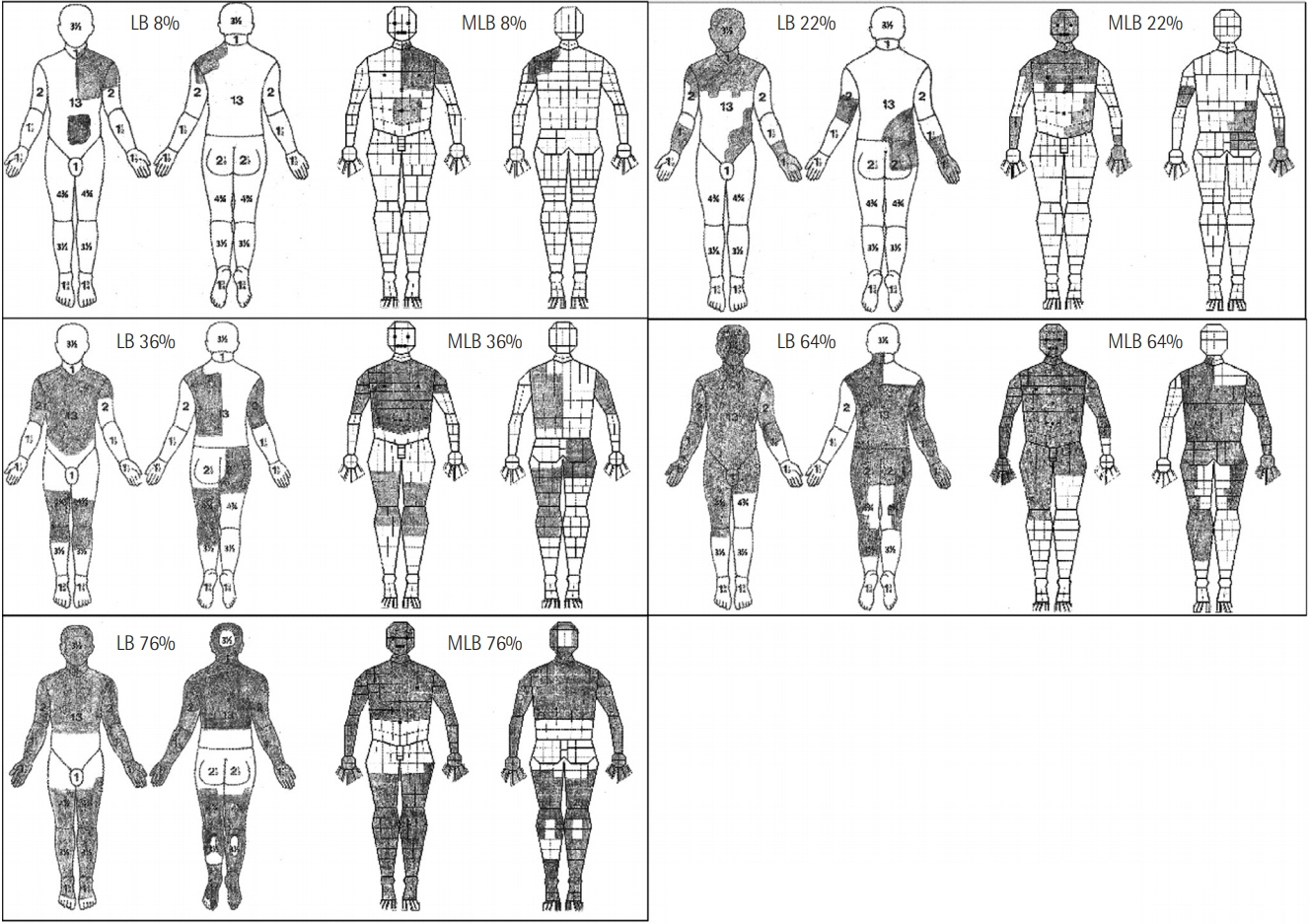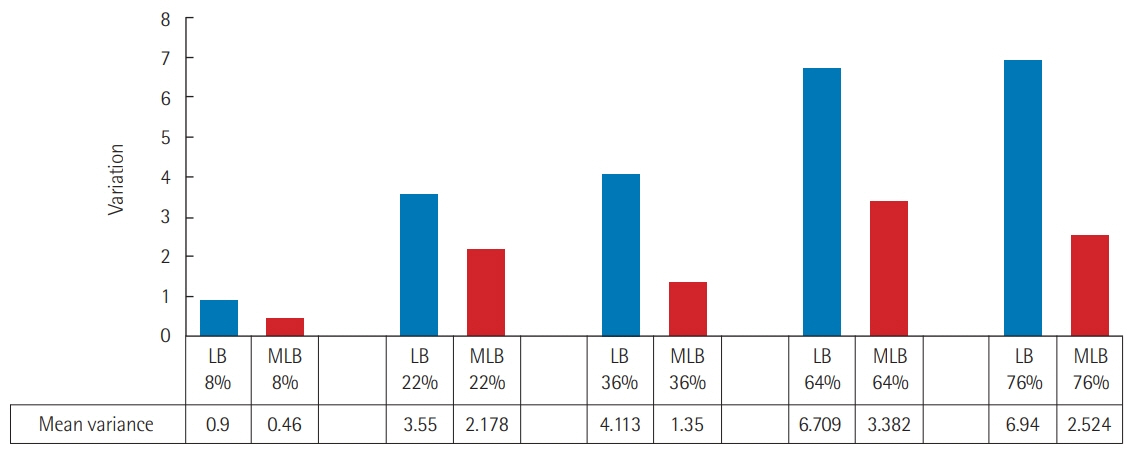Acute Crit Care.
2019 Nov;34(4):276-281. 10.4266/acc.2019.00647.
Lund and Browder chart—modified versus original: a comparative study
- Affiliations
-
- 1Department of Surgery, Fiji National University, Lautoka, Fiji. arunmurari@yahoo.com
- 2Department of Mathematics and Statistics, Fiji National University, Lautoka, Fiji.
- KMID: 2467307
- DOI: http://doi.org/10.4266/acc.2019.00647
Abstract
- BACKGROUND
The Lund and Browder (LB) chart is currently the most accurate and widely used chart to calculate total body surface area affected by a burn injury. However, it is not easy to use charts to calculate burn percentages because of the difficulty in performing mathematical calculations with the percentages attributed to various body regions that are only partially burned. It is also cumbersome to have to perform mental calculations, especially in emergency situations.
METHODS
We compared results from the LB chart with a modified Lund and Browder (MLB) chart using 10 assessors on five different burn wounds each drawn on both charts.
RESULTS
Variability of results was significantly reduced using the MLB chart compared to the LB chart.
CONCLUSIONS
Assessments performed using the MLB chart are less variable than those using the LB chart. Using this chart will help burn care providers rapidly, accurately, and reliably estimate burn extent.
MeSH Terms
Figure
Reference
-
1. Scott-Conner CE, Clarke KM, Conner HF. Burn area measurement by computerized planimetry. J Trauma. 1988; 28:638–41.
Article2. Stockton KA, McMillan CM, Storey KJ, David MC, Kimble RM. 3D photography is as accurate as digital planimetry tracing in determining burn wound area. Burns. 2015; 41:80–4.
Article3. Cheah AK, Kangkorn T, Tan EH, Loo ML, Chong SJ. The validation study on a three-dimensional burn estimation smartphone application: accurate, free and fast? Burns Trauma. 2018; 6:7.
Article4. Giretzlehner M, Dirnberger J, Owen R, Haller HL, Lumenta DB, Kamolz LP. The determination of total burn surface area: how much difference? Burns. 2013; 39:1107–13.
Article5. Kamolz LP, Lumenta DB, Parvizi D, Dirnberger J, Owen R, Höller J, et al. Smartphones and burn size estimation: “Rapid Burn Assessor”. Ann Burns Fire Disasters. 2014; 27:101–4.6. Amirsheybani HR, Crecelius GM, Timothy NH, Pfeiffer M, Saggers GC, Manders EK. The natural history of the growth of the hand: I. Hand area as a percentage of body surface area. Plast Reconstr Surg. 2001; 107:726–33.
Article7. Wallace AB. The exposure treatment of burns. Lancet. 1951; 1:501–4.
Article8. Berkow SG. A method of estimating the extensiveness of lesions (burns and scalds) based on surface area proportions. Arch Surg. 1924; 8:138–48.
Article9. Livingston EH, Lee S. Percentage of burned body surface area determination in obese and nonobese patients. J Surg Res. 2000; 91:106–10.
Article10. Wikipedia Contributors. Lund-Browder chart-burn injury area [Internet]. San Francisco (CA): Wikipedia Foundation;[cited 2019 Aug 15]. Available from: https://en.wikipedia.org/wiki/Lund_and_Browder_chart#/media/File:Lund-Browder_chart-burn_injury_area.PNG.11. Rumpf RW, Stewart WC, Martinez SK, Gerrard CY, Adolphi NL, Thakkar R, et al. Comparison of the Lund and Browder table to computed tomography scan three-dimensional surface area measurement for a pediatric cohort. J Surg Res. 2018; 221:275–84.
Article12. Murari A. A modified Lund and Browder chart. Indian J Plast Surg. 2017; 50:220–1.
Article13. Lund CC, Browder NC. The estimation of areas of burns. Surg Gynecol Obstet. 1944; 79:352–8.14. Miminas DA. A critical evaluation of the Lund and Browder chart. Wounds UK. 2007; 3:58–68.15. Lundin K, Alsbjørn B. The 101 percent in Lund-Browder charts: a commentary. Burns. 2013; 39:819–20.
- Full Text Links
- Actions
-
Cited
- CITED
-
- Close
- Share
- Similar articles
-
- ERRATUM: Corrected Figure Legend: Stroke Genetics: A Review and Update
- Haptoglobin Gene Polymorphism Is Associated With Lower Postoperative Cardiovascular Risk in Carotid Stenosis Patients
- Incontinence in Patients With Underactive Bladder
- Comparative Study of Fungus Ball and Chronic Bacterial Sinusitis
- Modified Badenoch Pull-Through Urethroplasty





